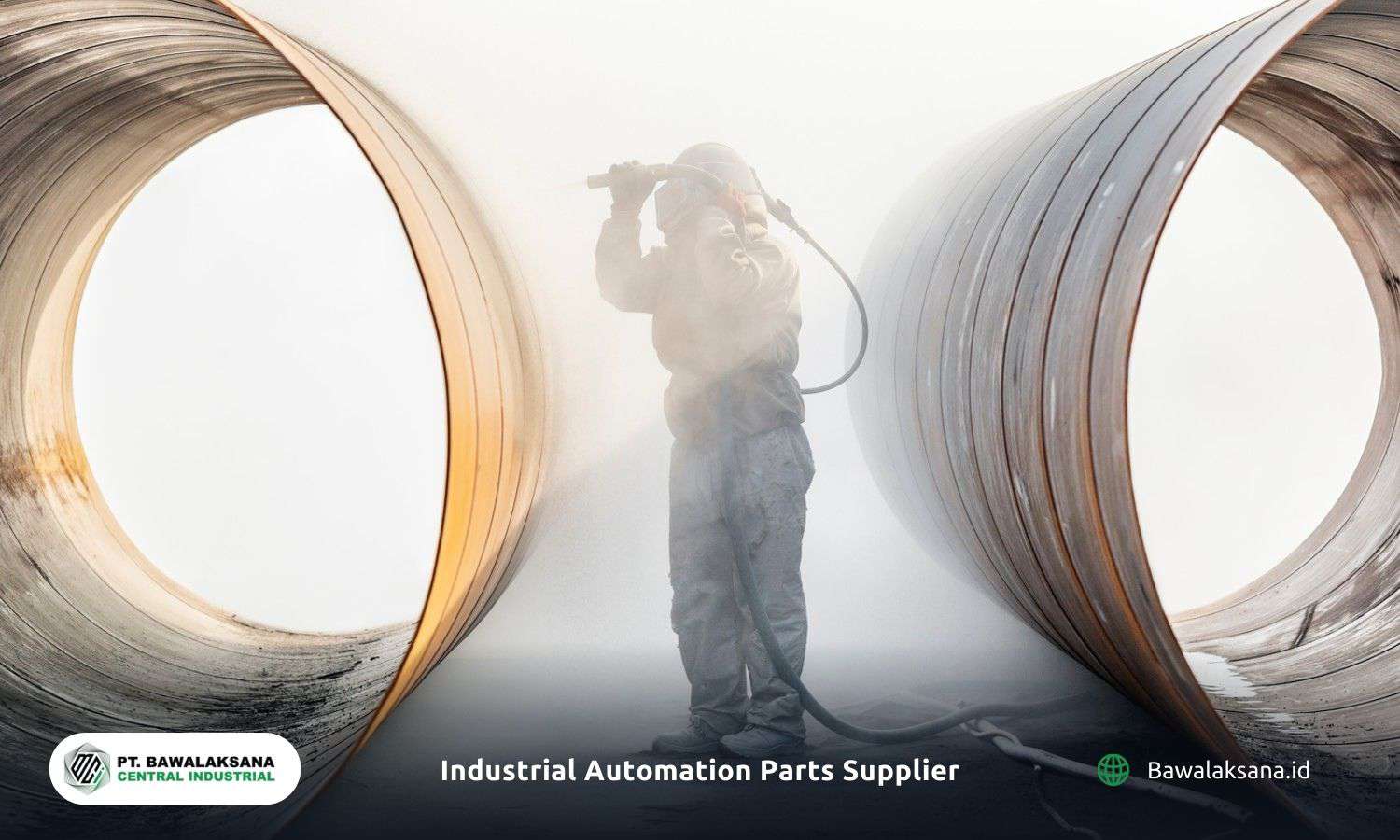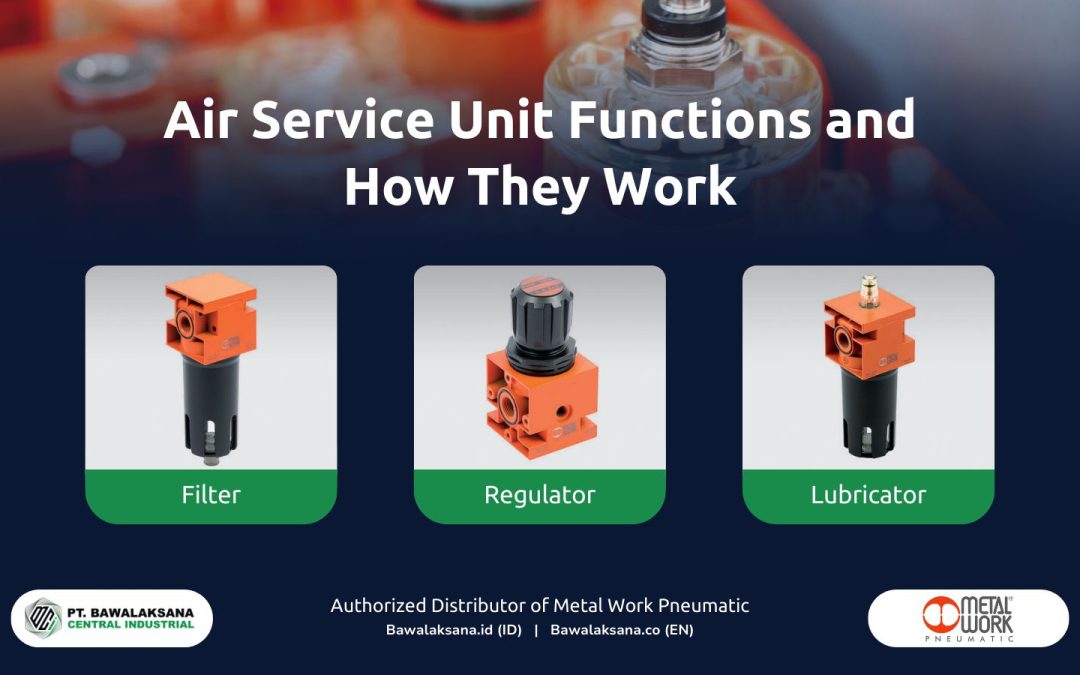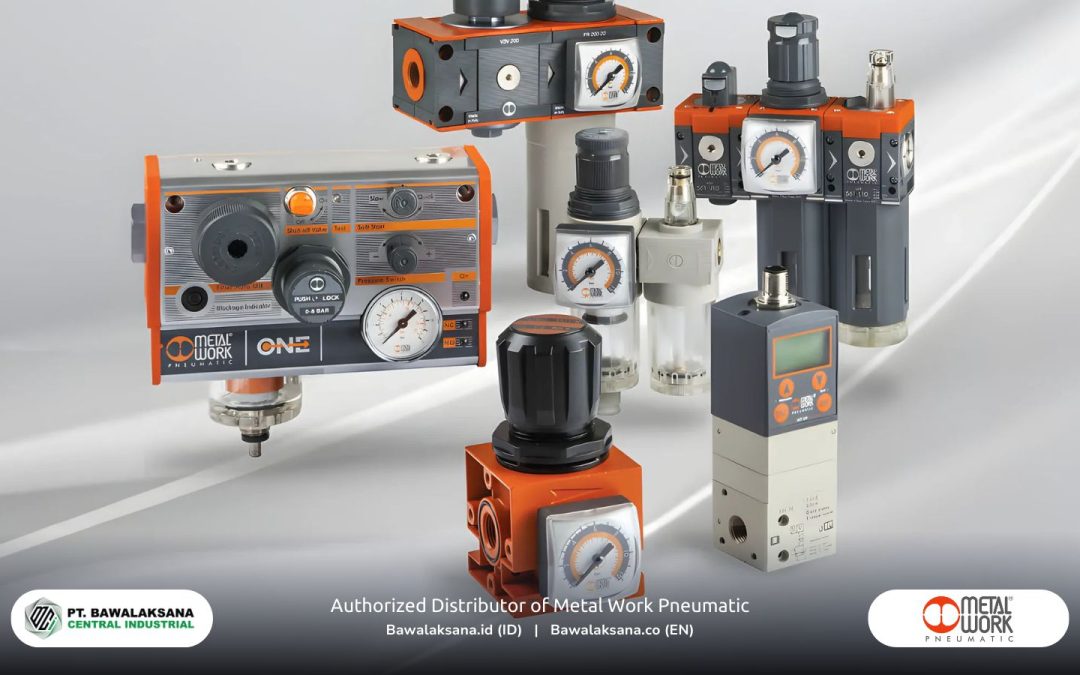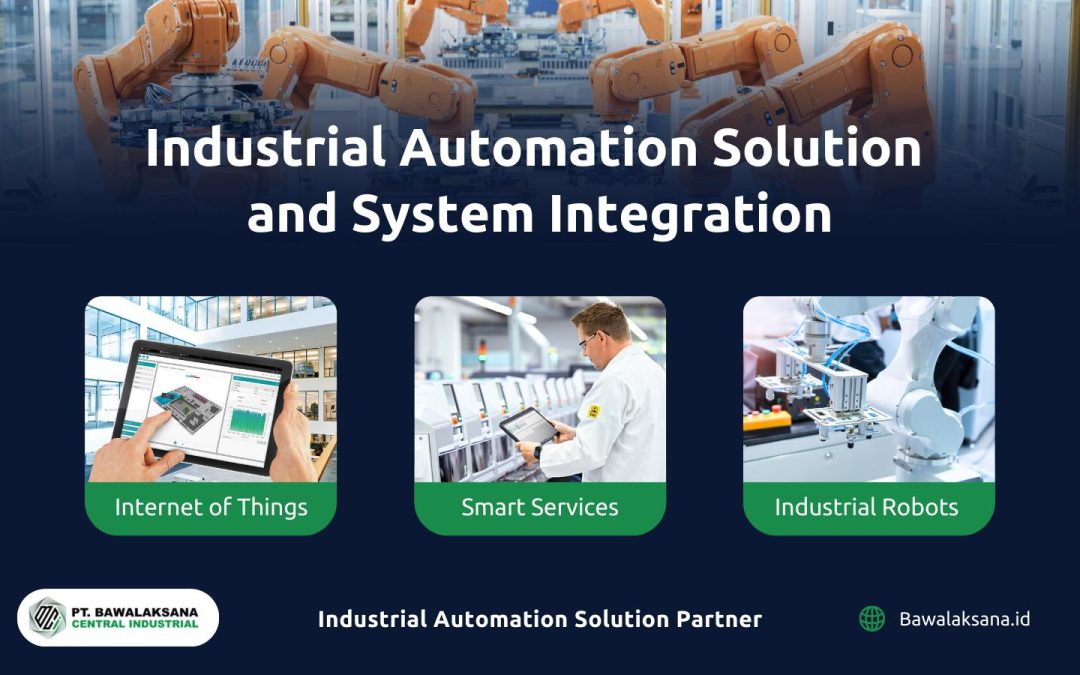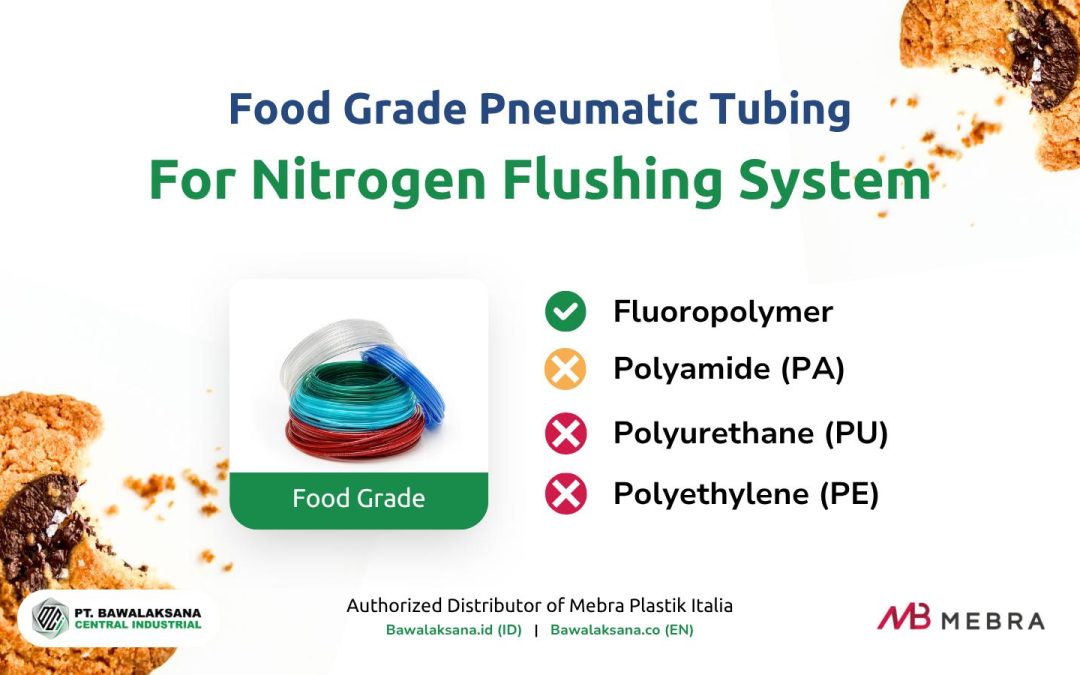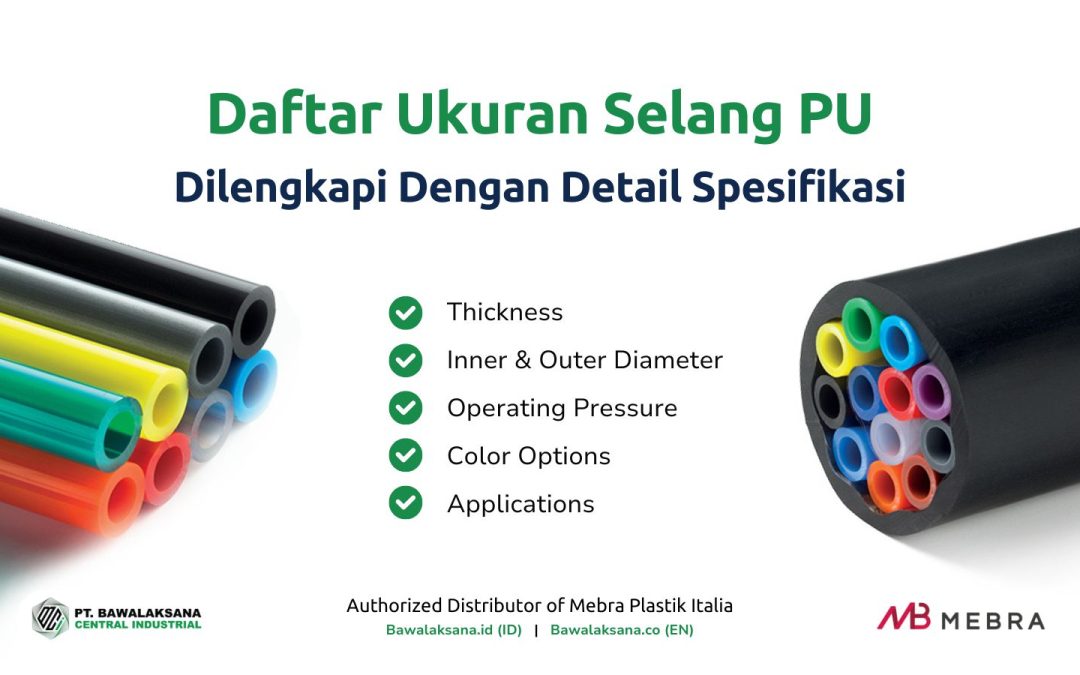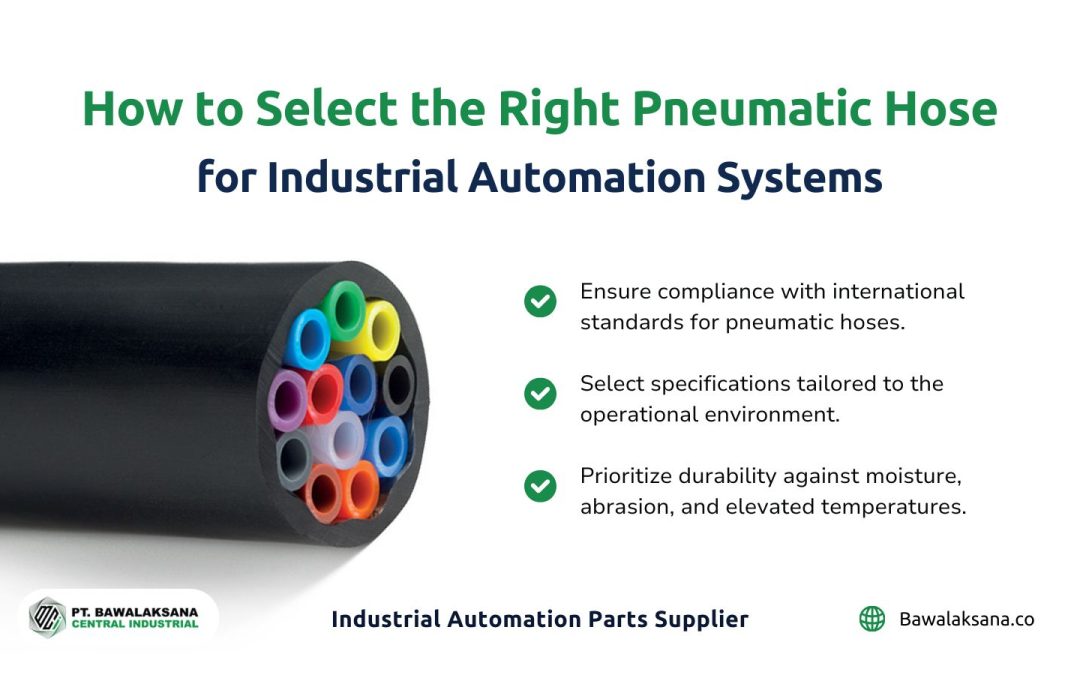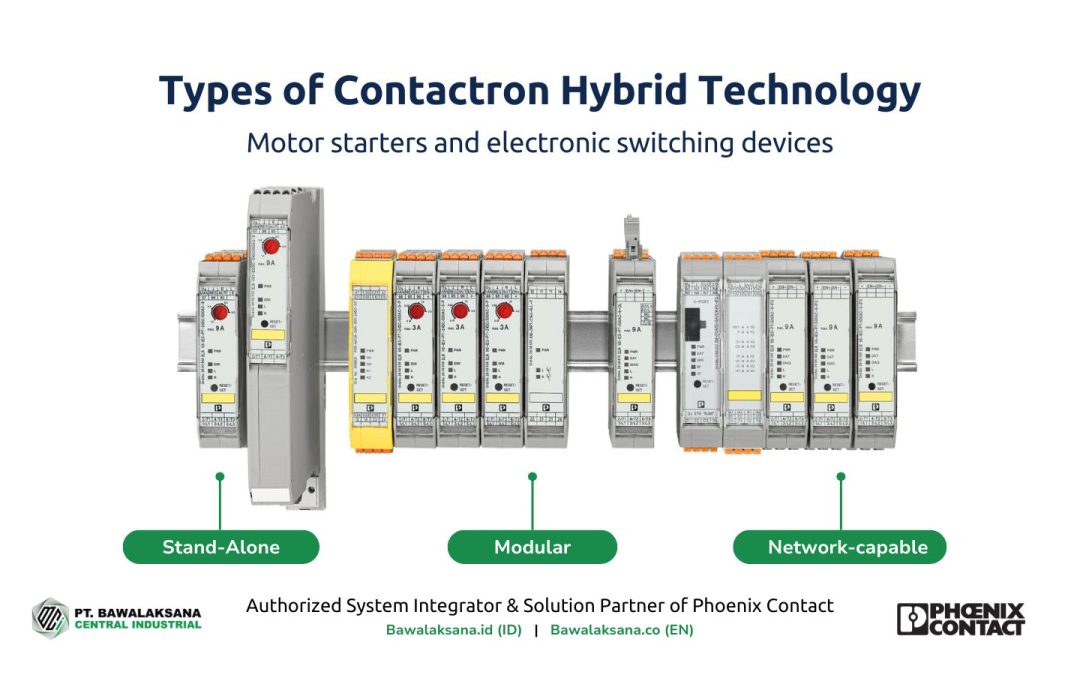Every day, you may have witnessed the use of various pneumatic tools in everyday life. From automatic doors, air braking systems, vacuum sealers, dental drills, jackhammers and more.
Among the examples of pneumatic tools are as follows:
- Pneumatic nail gun
- Jackhammer
- Pneumatic screwdriver
- Pneumatic cylinder
- Vacuum tube system
- Dentist drill
- Vacuum sealer
- Pneumatic door operator
- Air brake system
- Air suspension system
- Pneumatic grease gun
- Sandblaster
Whether we realize it or not, the fact is that pneumatic systems and equipment have become an important part of many aspects of our lives. Although, not many of us realize this due to our busy schedules.
But more than that, pneumatic technology has become a key component in the transition to Industry 4.0. Especially for sectors that are very critical, such as in industrial automation systems or smart manufacturing that adopts IIoT (Industrial Internet of Things).
Realizing how crucial pneumatic technology is in our lives, the Bawalaksana.id team feels the need to mention some examples of pneumatic tools in everyday life.
Let’s take a look at the full discussion below!
![10+ Examples of Pneumatic Tools in Daily Life and Industry [2025] 1 Pneumatic nail guns applied in residential roofing installation. A pneumatic riding gun for installing roofs.](https://bawalaksana.co/wp-content/uploads/2025/05/Pneumatic-nail-guns-applied-in-residential-roofing-installation-1024x614.jpg)
Pneumatic Nail Gun
The first example of a pneumatic tool that is often encountered in everyday life is the pneumatic nail gun. This tool is very popular in construction and woodworking.
The main function of a pneumatic nail gun is to nail wood or other materials that can be nailed.
Ride gun is a tool that can shoot nails into the wood surface with speed and precision driven by compressed air.
Working Mechanism of Pneumatic Nail Gun
The working mechanism of a pneumatic nail gun is actually quite simple. According to Nail Gun Depot, inside this tool is a sliding piston with a long shaft called a driver. This sliding piston can push the nail at high speed towards the specified target.
When the trigger is pressed, the air valve opens, creating a large air pressure against the piston making it move downward and hit the nail into the work surface.
When the trigger is released, the valve position will change and push the piston back to the starting position, ready for the next duty cycle.
Specifications and Safety of Pneumatic Nail Gun Tools
Most pneumatic nail guns are connected to a separately placed air compressor and connected with an air hose. The working pressure of this tool generally operates at a pressure of 70 to 120 Psi.
For your information, that pneumatic nail gun comes in various forms and special variations, including:
- Brad nail gun: for installing thin strips and fine trims
- Framing nail gun: for construction framing and heavy projects
- Coil nail gun: for sheathing, roofing, decking and fencing
- Staple gun: for upholstery, carpet installation and packaging
In general, this pneumatic nail gun tool offers very significant work efficiency. In fact, it can cut down the work time to be shorter compared to the manual stiffening technique.
By using this tool, the depth of the nail position embedded into the work surface becomes more consistent, resulting in better material integrity.
However, according to a report from OSHA (Occupational Safety and Health Administration), pneumatic nail guns contribute to approximately 37,000 emergency room admissions each year. Injuries are often caused by accidental nail discharge, including double-shot and ricochet injuries.
![10+ Examples of Pneumatic Tools in Daily Life and Industry [2025] 2 Jackhammers are utilized in the construction sector for breaking concrete. Pneumatic powered jackhammer for building construction field.](https://bawalaksana.co/wp-content/uploads/2025/05/Jackhammers-utilized-in-the-construction-sector-for-breaking-concrete-1024x614.jpg)
Jackhammer
The next pneumatic tool that we often encounter in our daily lives is the jackhammer. The function of the jackhammer is to break concrete, stone and asphalt.
Jackhammers are widely used on construction sites with a loud and distinctive rhythmic tapping sound.
Function of Jackhammer on Construction Site
The pneumatic jackhammer tool is an alternative work tool to replace the sledgehammer commonly used to crush hard objects in a construction environment.
Just like a pneumatic nail gun, a jackhammer also uses compressed air power supplied from a compressor engine through a thick and strong hose.
Quoting from Explain That Stuff, that inside the jackhammer there is a mechanical system consisting of various circuits, such as:
- Valve
- Heavy piledriver
- Air tube
- Drill that moves up and down
Did you know that a jackhammer can strike the ground about 1500 times per minute? This kind of fast frequency can certainly improve time efficiency for the work of breaking hard objects.
Compared to using a sledgehammer, a worker may only be able to deliver 10-15 blows per minute.
For information, that the mechanical system for the jackhammer varies according to the design of the vendor who makes it. Even so, the function of each jackhammer remains the same, namely to break hard materials such as concrete, stone and asphalt.
Similar to the pneumatic nail gun, the jackhammer tool is also equipped with a trigger to control the operation in hitting the ground or hard objects.
Types of Construction Jackhammer
Jackhammers have several types and variations based on the power source used to operate, as follows:
- Pneumatic Jackhammer: This is the most powerful and widely used type in the industry. This type is the most superior because it can break down very hard materials and can operate continuously without worrying about overheating.
- Electric Jackhammer: The electric jackhammer is more portable and silent than the pneumatic version. Electric jackhammers require a steady supply of electricity to operate. The downside of this type is that it is not very good at breaking down very thick materials, given the fairly limited power of the motor.
- Hydraulic Jackhammer: This is the largest and most powerful type as it is generally attached to heavy equipment such as excavators or backhoes. This type is powered by pressurized hydraulic fluid and is generally used for larger and heavier jobs, such as mining and demolition of large materials.
By using a jackhammer, the task of breaking concrete, stone or asphalt can be done quickly and effortlessly. Operators can work more effectively and reduce fatigue significantly.
![10+ Examples of Pneumatic Tools in Daily Life and Industry [2025] 3 Pneumatic screwdrivers used in product assembly lines. Pneumatic screwdriver for assembly line in manufacturing.](https://bawalaksana.co/wp-content/uploads/2025/05/Pneumatic-screwdrivers-used-in-product-assembly-lines-1024x614.jpg)
Pneumatic Screwdriver
A pneumatic screwdriver is a tool that works to tighten or loosen screws quickly and effectively. This tool can work by using compressed air power supplied from an air compressor.
The use of pneumatic screwdrivers is widely found in various industrial sectors such as automotive manufacturing, electronics, construction or workshops.
By using a pneumatic screwdriver, the assembly process can be done quickly and safely.
How a Pneumatic Screwdriver Works
Broadly speaking, a pneumatic screwdriver works by converting compressed air into mechanical energy. High-speed air flows inside the screwdriver and creates a rotational motion that can turn the screwdriver tip.
The speed and torque of the pneumatic screwdriver can of course be controlled easily with a trigger. That way, the speed and torque can match the needs of the application.
Common Types and Specifications of Pneumatic Screwdriver
Today, the types of pneumatic screwdrivers are numerous, but there are generally two forms used in the industrial sector:
- Straight: Suitable for screw installation on medium to large-sized machines with a practical and simple grip. This first type varies in size and features.
- Pistol: More ideal for assembly applications of small plastic, wooden or electronic items. However, for the automotive sector the pistol form is also commonly used for unscrewing screws and there are also types that offer large torque.
Clutch Type for Pneumatic Screwdriver
The diverse challenges in today’s industrial sectors have demanded new innovations for pneumatic screwdrivers. Therefore, there are now several types of couplings available from this tool to support optimal performance, such as the following:
- Impact drive: Usually used for heavy-duty work in the automotive and construction sectors. This type can deliver an impact to provide a great ability to tighten or loosen.
- Direct drive: Suitable for applications where precise torque control is not important, such as screwing into wood or walls. This type has a simple design where the air motor is directly connected to the screwdriver tip without a torque limiter.
- Shut-off clutch: This type is ideal for applications that require high accuracy, such as electronic assembly or automotive components. This type of screwdriver will automatically shut-off power to the screwdriver when the desired torque is reached. The pneumatic motor and screwdriver tip will stop completely to prevent over-tightening so that the torque applied can be limited with great precision.
- Positive-action clutch: This type is suitable for applications that require torque consistency and fast tightening, but the level of precision is not as high as a shut-off clutch. This type can also provide direct and constant torque up to a predetermined limit. However, the motor continues to rotate and the tool can still operate if pressed.
- Roller clutch: This type is suitable for applications that require repeated tightening with a medium degree of precision. Roller-type clutches use a roller mechanism within the clutch to transfer power, as well as externally adjustable torque settings.
For information, that the selection of the coupling type in a pneumatic screwdriver needs to be adjusted according to the application needs, the level of torque precision and the characteristics of the material being worked on.
As regards the torque range for pneumatic screwdrivers, it is very wide. Ranging from 0.20 kgm to over 3.06 kgm, and with a rotation speed of up to 14,000 rpm.
![10+ Examples of Pneumatic Tools in Daily Life and Industry [2025] 4 Types of Pneumatic Cylinders or Pneumatic Actuators and How They Work - Bawalaksana ID](https://bawalaksana.co/wp-content/uploads/2024/03/Silinder-Pneumatik-Jenis-dan-Cara-Kerjanya-Bawalaksana-ID-1024x614.jpg)
Pneumatic Cylinder in Industrial Automation
Pneumatic Cylinder is a device that functions to convert energy (compressed air) into mechanical motion (linear or rotational).
Pneumatic cylinders are an important part of pneumatic automation systems in the industrial sector. These pneumatic tools are found in various general to specialized industrial sectors, such as automotive, F&B, packaging, electronics manufacturing, pharmaceuticals, to the most specialized ones such as the petrochemical industry.
The function of pneumatic cylinders in industry is to move goods, cut, control conveyors, packaging, filling and others.
However, pneumatic cylinders are also widely used for various purposes, both for DIY, press machines, pushing tools, jacks and others.
Pneumatic Cylinder Types and Applications
There are many types of pneumatic cylinders as we have discussed in the previous article, Pneumatic Cylinders: Components, Types and How They Work. It can be simply divided into 4 based on the type of movement it produces, as follows:
- Linear Pneumatic Cylinder: Produces linear or straight motion.
- Rotary Pneumatic Cylinder: Produces rotational or rotary motion.
- Rotolinear Pneumatic Cylinder: Produces a combination of linear and rotational motion.
- Rodless Pneumatic Cylinder: A development of the Linear Pneumatic Cylinder but does not have an externally extending piston rod component.
Pneumatic cylinders are likened to muscles and are an important part of the Pneumatic System. To operate this tool, pressurized air is required ranging from 5-10 BAR (72-145 Psi) according to the workload.
The following are some examples of pneumatic cylinder applications that you can encounter in everyday life and in vital industrial sectors:
- Automatic door opening and closing for buses and trains
- Pneumatic-powered presses and cutting tools
- Filling machine for cosmetic, F&B and pharmaceutical industries
- Product lifting and moving process on the production line
- Packaging machine
- And others
Key Components in the Transition to Industry 4.0
Pneumatic cylinders can be utilized for various sectors, ranging from DIY to modern and sophisticated industrial automation systems.
This technology has been found in many aspects of life. Therefore, it is no wonder that it has been named as key in the transition to a modern and smart Industry 4.0.
As an integral part of a pneumatic system, it has become a sought-after tool for green manufacturing that is concerned about energy efficiency and sustainable productivity. green manufacturers concerned with energy efficiency and sustainable productivity..
![10+ Examples of Pneumatic Tools in Daily Life and Industry [2025] 5 Vacuum Tube Transportation System - Courtesy Air-Log (dot) com. A pneumatic tube device for logistics transportation in a modern hospital.](https://bawalaksana.co/wp-content/uploads/2025/05/Vacuum-Tube-Transportation-System-Courtesy-Air-Log-dot-com-1024x614.jpg)
Pneumatic Vacuum Tube Systems
The next pneumatic device that can be found in everyday life is the Pneumatic Vacuum Tube System found in hospitals.
This pneumatic device serves as a logistical transportation tool that connects a number of important areas within the Hospital to optimize health care and services.
Although in Indonesia this technology is not very familiar, in American and European countries it has been widely applied since the 1920s.
In fact, this kind of technology dates back to the 1800s, invented by an American merchant named John Wanamaker. He introduced pneumatic tubes as a means of transporting documents for post offices in the United States and his own private shop.
It can be used to transport mail or money from one area of a building to another quickly and practically.
A complete history of pneumatic technology in general is outlined in our article What is Pneumatics: History, Development and Application in Industry.
Main Functions of Pneumatic Vacuum Tube System in Hospital
At this time, the term Pneumatic Tube began to be widely recognized in the world community as a means of transportation or carrier for documents, laboratory test results and transportation of medicines in modern hospitals.
This transportation tool is built using compressed air or vacuum channels that are automatically regulated by the system.
It is important to note that the term Pneumatic Tube can refer to two things:
- A pneumatic hose used to deliver pressurized air to all parts of a pneumatic automation system in industry.
- Logistics transportation between facilities within a modern hospital.
On this occasion, we will explain the main functions of Pneumatic Tube in the context as a logistics transportation tool in hospitals. Some of its main functions include:
- Improve efficiency between hospital divisions in managing the movement of critical documents and materials.
- Safety for medical personnel, where documents or samples from patients can be sent safely through air ducts that are well integrated in the hospital environment.
- Save time and improve service quality in treating patients using vacuum tube (carrier) transportation tools that are fast and effective.
Pneumatic Vacuum Tube can be a logistics transportation tool for several things such as the following:
- Laboratory samples (blood, tissue, urine, etc.)
- Medicines and pharmaceutical products
- Blood products for transfusion
- Medical instruments and equipment
- Important documents and test results
![10+ Examples of Pneumatic Tools in Daily Life and Industry [2025] 6 Trajectory of Vacuum Tube Transportation System - Courtesy Swisslog Healthcare. Channels for pneumatic tubes for logistics transportation in modern hospitals.](https://bawalaksana.co/wp-content/uploads/2024/01/Hospital-Pneumatic-Tube-System-By-Swisslog-Healthcare.jpg)
![10+ Examples of Pneumatic Tools in Daily Life and Industry [2025] 7 A doctor in a hospital holds a vacuum tube to be used as a pneumatic transportation tool for logistics in the hospital.](https://bawalaksana.co/wp-content/uploads/2024/01/Hospital-Pneumatic-Tube-System-By-Swisslog-Healthcare-02-1.jpg)
Image caption: Transportation using compressed air in a modern hospital, image by Swisslog Healthcare.
According to Swisslog Healthcare, by using the Pneumatic Tube System in hospitals, the efficiency of health services can be significantly improved. Health workers can save up to 200 hours/day compared to using manual transportation on foot.
One of the largest Pneumatic Tube System networks in Europe is at Klinikum rechts der Isar Munich, with more than 200 stations and 1,300 carriers. With this capacity, the system can handle about 3,300 logistics transports every day.
Meanwhile, Erasmus University Medical Center in Rotterdam has a system that stretches over 16 kilometers, with a capacity of about 400 carriers/hour.
History and Development of Pneumatic Vacuum Tube System
Quoting from Technology Review, the Pneumatic Tube System has been predicted to revolutionize various industries since the 19th century to the mid-20th century.
Initially, this technology was widely used in retail stores, banks, post offices and was even planned for public transportation such as the subway in New York City.
However, with the development of other technologies such as truck transportation, digitalization and ATMs, its use declined drastically and almost became extinct.
However, one sector that has maintained and developed this technology is Hospitals, since the 1920s. Later, in the 1960s it became the standard in the construction of new hospitals.
With this technology, health workers can save a lot of time instead of having to manually deliver goods back and forth.
Today, the Pneumatic Tube logistics system in hospitals is increasingly modern and can reach up to 12 miles of pipelines, such as those in Penn Medicine Hospital, Philadelphia. The delivery speed can reach between 12-16 miles/hour.
With the rapid advancement of technology, Pneumatic Vacuum Tube can now be integrated with computers to monitor and manage delivery in real-time.
![10+ Examples of Pneumatic Tools in Daily Life and Industry [2025] 8 High-speed dental drills used in professional dental clinics. A pnuematic drill is a pneumatic tool that is widely used in dental clinics.](https://bawalaksana.co/wp-content/uploads/2025/05/High-speed-dental-drills-used-in-professional-dental-clinics-1024x614.jpg)
Dentist Drills
The small dental drill with the distinctive buzzing sound is called Dental Handpiece. These pneumatic tools belonged to the great evolution for dental techniques in medieval times.
Can you believe it?
The pneumatically powered dental handpiece can reach a maximum rotation of up to 400,000 rotations per minute (RPM). It’s amazing isn’t it!
This means that the drill is the fastest spinning tool ever.
By the way, have you experienced Dental Handpiece in person at a dental clinic?
Most of us wouldn’t want to face a situation like this, as it’s very scary (smile mode-on).
It is undeniable that the loud ringing sound of the drill often makes patients feel uncomfortable or uneasy when being treated by a dentist.
The good news is, we’re not going to talk about how crunchy these teeth are when it comes to the thrill of the Dental Handpiece.
Because, in this article we will discuss the technicalities of dental drills and their benefits in the field of dentistry.
Technical Specifications and Advantages of Pneumatic Powered Handpieces
Pneumatic powered dental handpieces generally measure around 0.8 mm to 13.7 mm depending on the variation. At the end (head) there is a turbine that will rotate very quickly when flowed by pressurized air.
According to Hayes Handpiece, the workings of a dental drill are as summarized in the following points:
- Compressed air flows through the center of the instrument (grip section) to the end of the drill (head).
- When the air reaches the head, it spins the turbine so fast that it reaches between 300,000 and 400,000 rpm depending on the size of the turbine.
- After driving the turbine, the air flows backwards towards the shell section and exits through the exhaust hole.
- The air continues to flow in such a way while the appliance is operating and this continuous flow also serves to prevent damage to sensitive teeth due to the heat generated.
Advantages of Pneumatic Dental Drill
Dental drills powered by compressed air (pneumatics) have many advantages, including the following:
- It has a lighter weight than electric dental drills and a more balanced grip that reduces operator fatigue.
- It has a minimalist size, making it easy to maneuver in tight gear spaces.
- More sensitive feedback through sound when in contact with the tooth structure, ensuring optimal caution when operating the tool.
- It has a higher maximum speed of up to 400,000 rpm, compared to the electric-powered one that only reaches 100,000 rpm.
For your information, the Dental Handpiece applies a low working pressure, which is between 35-61 Psi.
Meanwhile, according to Dentaltix, the drill’s rotation speed can decrease between 50,000 rpm and 300,000 rpm when it encounters resistance.
Then the head can be equipped with 3-5 point jets that can spray water as a coolant. This is important to help prevent heat buildup that can damage teeth or cause discomfort for the patient.
![10+ Examples of Pneumatic Tools in Daily Life and Industry [2025] 9 Vacuum sealers are used for efficient and hygienic food packaging. Vacuum suction device for packaging and preserving food.](https://bawalaksana.co/wp-content/uploads/2025/05/Vacuum-sealers-used-for-efficient-and-hygienic-food-packaging-1024x614.jpg)
Vacuum-Sealer
The next pneumatic tool around us is a vacuum sealer that functions to package and preserve food in a natural way.
Whether we realize it or not, this tool actually applies pneumatic working principles. This tool can suck and remove air in food containers that are generally made of plastic bags.
How a Vacuum-Sealer Works
The way a vacuum-sealer works is by sucking or removing air from the food storage area. The food containers used are usually special sterile plastics that can be firmly glued together.
Vacuum-sealers are able to create vacuum pressure (negative pressure) significantly, so that the pressure inside the food container will be lower than atmospheric pressure..
For your information, vacuum-pressurized food storage can inhibit bacterial growth and oxidation. Therefore, the food stored in this place can last longer.
Main Functions of Vacuum-Sealer
The following are important benefits of using a pneumatic vacuum-sealer to store food:
- The freshness of the stored food will last longer than if it is stored in conventional containers.
- Protection of nutrients and flavor through elimination of oxidation.
- Storage is more space-saving as containers are slim and stack efficiently.
- The storage period of food will be longer, and it will not change easily in terms of flavor, texture or nutritional value, for example for fresh meat and fruits.
![10+ Examples of Pneumatic Tools in Daily Life and Industry [2025] 10 Pneumatic Door Operator Application - Courtesy Dhi (dot) org. Pneumatic doors as a means of automatically opening and closing doors in modern buildings.](https://bawalaksana.co/wp-content/uploads/2025/05/Pneumatic-Door-Operator-Application-Courtesy-Dhi-dot-org-1024x614.jpg)
Pneumatic Door Opener/Closer
Automatic doors found in office buildings or malls are clear evidence that pneumatic tools and technology can be found in everyday life.
In this modern era, doors that can close or open automatically have become vital in various public places.
Please note that automatic doors can actually be powered by three types of energy, namely electricity, pneumatics and hydraulics.
And actually, automatic doors operated by pneumatic systems have many advantages compared to others, such as:
- Silent and clean operation
- Can meet ADA (Americans with Disabilities Act) standards
- Has simple controls and low installation costs
- Flexibility in terms of configuration to enhance functionality and aesthetics
How an Automatic Pneumatic Door Works
Similar to how pneumatic systems work in general, pneumatic door operators work by utilizing compressed air supplied by an air compressor.
The vital component of this automatic door is a modified heavy-duty door operator with a pneumatic cylinder.
At the same time, the cylinder component becomes the driving muscle in charge of opening or closing the door leaf automatically based on the command from the control box.
![10+ Examples of Pneumatic Tools in Daily Life and Industry [2025] 11 Pneumatic Door Operator Diagram - Courtesy Dhi (dot) org. Diagrams for the pneumatic door operating system.](https://bawalaksana.co/wp-content/uploads/2025/05/Pneumatic-Door-Operator-Diagram-Courtesy-Dhi-dot-org-1024x614.jpg)
Door operators can be installed in several places to customize the desired configuration, either visible or invisible.
Door operators can be mounted on the pull or push side of the door leaf, and can also be mounted on the hinge (not visible) for low ceiling situations.
Automatic pneumatic doors have a control box that can be located up to 30 meters away from the door operator who is responsible for managing door operations.
Meanwhile, the compressor supplies pressurized air to the side of the control box and then continues to the operator’s door through the Pneumatic Tubing.
Pros of Automatic Pneumatic Door
Pneumatic door operators are the best choice with various considerations, such as flexibility, durability, accessibility and safety. Quoting from Dhi.org, here are some advantages for automatic pneumatic doors:
- Silent Operation: Automatic pneumatic doors are known for their low noise when operating. This advantage becomes crucial for specialized applications that require quietness such as libraries, places of worship, offices or hospitals.
- Flexibility: Pneumatic doors are available in many mounting configurations, such as concealed or visible mounting. It can be mounted on the pull or push side of the door leaf, as well as can be mounted on the hinge section for low ceiling situations.
- Durability: Door operator mechanisms for pneumatic doors are available in sturdy cast iron designs for long, trouble-free service. Special designs are also available for heavy door applications that require back-check damage protection to prevent damage when the door is closed or opened too hard.
- Accessibility: Automatic pneumatic doors can meet ADA (Americans with Disabilities Act) standards making them friendly for people with disabilities. With a simple mechanism, pneumatic doors can meet both functional and aesthetic standards.
- Safety: Pneumatic door operators do not require a high-voltage electrical supply so they can be used in critical environments safely. Door operation can be controlled via a control box from a distance of 30 meters connected to a pneumatic hose.
- Cost Effective: Besides being superior in terms of flexibility, durability and safety, pneumatic doors excel in terms of low installation costs compared to other door operators (electric or hydraulic). One control box can be used to operate two pairs of door leaves simultaneously.
Finally, automatic pneumatic doors are pneumatic tools that can be found around us but are often ignored.
Thus, we have realized that pneumatic technology has played many roles in various aspects of our lives. Therefore, we should be grateful for all these conveniences.
![10+ Examples of Pneumatic Tools in Daily Life and Industry [2025] 12 Air reservoirs in container trucks supporting air brake systems. Air reservoir for the penumatic braking system in container trucks.](https://bawalaksana.co/wp-content/uploads/2025/05/Air-reservoirs-in-container-trucks-supporting-air-brake-systems-1024x614.jpg)
Air Brakes System
When you’re near a red light, it’s common to hear the hissing sound of a bus or truck braking.
Did you know that the sound actually comes from the air brake system?
In fact, air braking systems have become the gold standard for heavy vehicles such as trucks and buses. In fact, the train braking system also uses a pneumatic brake system because it is considered more effective and safe.
The air braking system on trains can distribute braking power evenly to the entire set of cars, thereby reducing the risk of plummeting or derailing.
Air Brake System Components
According to Newfoundland and Labrador (Canada), the basic components for air brake systems on trucks and buses are as follows:
- Air Compressor: Works to absorb air from the surroundings, compress and deliver it to the water reservoir.
- Air Reservoir: Serves to store pressurized air and deliver it to other parts of the air braking system through pneumatic tubing.
- Foot Valve: Function to open or close the flow of pressurized air from the air reservoir to the braking system when needed.
- Brake Chambers and Slack Adjusters: Being a means of transferring the force exerted by compressed air to the mechanical parts of the braking system.
- Brake Linings and Drums/Rotors: These are braking shoes (pads) that form an important part of the braking system. Their main function is to create the friction necessary to decelerate and stop the vehicle.
- Spiral Pneumatic Tubing: This is a pneumatic spiral hose (Air Brake Spiral Hose) industry standard for container truck air braking systems. Generally has a DIN 73378 certificate.
Note that the air braking system for buses and trucks can have very different components to the air braking systems on trains. As we have discussed in previous articles.
![10+ Examples of Pneumatic Tools in Daily Life and Industry [2025] 13 Air spring bags serving as spring replacements in air suspension systems. Pneumatic suspension system on a car.](https://bawalaksana.co/wp-content/uploads/2025/05/Air-spring-bags-serving-as-spring-replacements-in-air-suspension-systems-1024x614.jpg)
Air Suspension System
Along with braking systems, air suspension is also a pneumatic application found in transportation vehicles.
Instead of using conventional metal springs, air suspension uses air-filled rubber bags to support the weight of the vehicle and dampen vibrations during the ride.
Advantages of Air Suspension System
Air suspension systems are generally preferred over conventional suspensions that use metal springs. Here are some of the reasons why:
- Air suspension systems offer greater comfort and can reduce fatigue on long journeys.
- There is also greater flexibility to add or subtract air from the suspension bags, so the ground clearance of the vehicle can be adjusted easily.
Air Suspension System Components and Their Functions
Quoting from Samsara, the following are the main components of air suspension and their functions for land transportation fleets:
- Air Spring Bags: Functions as a substitute for steel springs to support the weight of the vehicle. These air bags also serve to absorb shocks and vibrations from the road surface so as to provide driving comfort.
- Air Compressor: Serves to supply pressurized air to the air suspension system. The compressor is usually driven by the vehicle engine and is also used for the air brake system.
- Air Reservoir: Serves as a storage place for pressurized air produced by the compressor before being channeled to the air spring bags and air brake system.
- Valves: Valves play an important role in regulating the air flow to and from the air spring bags. They help to regulate the air pressure in the air bags, so that the height and stiffness of the suspension can be adjusted according to the load and road conditions.
- Air Lines: These are pneumatic hoses that function to deliver air to various components such as compressors, air tanks, valves and air spring bags.
All the components we have mentioned above contribute to providing comfort while driving.
By keeping each component of the air suspension in optimal condition, you can feel the comfort and stability of driving, and can adjust the height of the vehicle according to the load and road conditions.
![10+ Examples of Pneumatic Tools in Daily Life and Industry [2025] 14 A technician operating a grease gun to lubricate moving parts in heavy machinery. An operator uses a pneumatically powered grease tool.](https://bawalaksana.co/wp-content/uploads/2025/05/A-technician-operating-a-grease-gun-to-lubricate-moving-parts-in-heavy-machinery-1024x614.jpg)
Pneumatic Grease Gun
The next pneumatic equipment that most people rarely think of is the grease gun or pneumatic grease gun.
Grease gun is a tool used to add lubricants or grease to certain locations on machines or mechanical equipment that require lubrication.
This tool plays an important role in making it easier for technicians to provide lubrication to vital machine parts such as gears, hinges and areas that are difficult to reach directly.
How a Pneumatic Grease Gun Works
The way a pneumatic grease gun works is quite simple, where pressurized air pushes the piston which then forces the grease out through a small channel.
Grease guns can generally produce pressures between 4,000 Psi to 6,000 Psi depending on the type.
The advantages of using a grease gun in a workshop or workshop are as follows:
- Prevents Waste: Using a grease gun allows you to adjust the amount of grease required each time you pull the trigger. This prevents the usual grease wastage that occurs when lubricating manually.
- Better Lubricant Saturation: You can deliver grease directly to the exact area that needs it.
- Speed and Accuracy: In a workshop environment that demands speed and accuracy, grease guns are very helpful in the process of fast and effective lubrication. For example, lubricating the underside of a car or truck, especially in areas that are difficult to reach and require the use of a grease gun.
![10+ Examples of Pneumatic Tools in Daily Life and Industry [2025] 15 Sandblasting large-diameter pipes to remove surface contaminants. An operator uses a pneumatically powered sand blaster to remove scale from a large iron pipe.](https://bawalaksana.co/wp-content/uploads/2025/05/Sandblasting-large-diameter-pipes-to-remove-surface-contaminants-1024x614.jpg)
Sandblaster
Sandblasters are pneumatic tools that can be found in industrial workshops and restoration facilities. It utilizes compressed air and can spray high-strength abrasive media through a handheld nozzle.
The process is known as abrasive blasting to the work surface to remove unwanted material or create a specific surface texture.
How the Sandblaster Works and Functions
Sandblasters work on a pneumatic principle where an air compressor supplies pressure to the spray gun to propel high-speed abrasive particles.
According to Solar Industries, the working pressure for sandblasting is 6 BAR (87 Psi) and stable pressure is also required. Meanwhile, the compressor capacity used is 265 CFM to 390 CFM and a screw compressor is recommended.
However, the actual working pressure and capacity of the compressor depends on the field application and the work surface at hand. The most important thing is that the airflow is stable and the compressor can run continuously as long as the system is operated.
When sandblasting, more air is released compared to pneumatic applications in other sectors.
Meanwhile, the holes in the spray gun are subject to wear and tear over time, which will encourage the use of more air than the original design.
The functions of the sandblaster are as follows:
- Remove paint that has adhered to the work surface
- Rust removal and work surface cleaning
- Preparation process for media to be painted or coated
- Making textured and decorative carvings
As we mentioned earlier, sandblasters can spray high-speed abrasive media to remove unwanted materials. The abrasive media that are often used include:
- Aluminum oxide
- Glass beads
- Shattered flakes of glass
- Walnut shell
- Silicon carbide
- Plastic powder
Differences in abrasive media selection can have a significant effect on the work surface. This adjusts to the hardness of the abrasive media used and the type of work media encountered.
These are some examples of pneumatic tools that can be found in everyday life and in various industrial sectors.
Hopefully, the information we present here can provide insight for those of you who are interested in exploring everything related to pneumatic technology.
If you are interested in learning more about pneumatic system technology, please visit our article Pneumatic System Applications in Electronics Manufacturing and Their Functions.
![10+ Examples of Pneumatic Tools in Daily Life and Industry [2025] 16 PT. Bawalaksana Central Industrial | Bawalaksana.co (EN) - Bawalaksana.id (ID). Reliable partner for automation system implementation in industry 4.0](https://bawalaksana.co/wp-content/uploads/2025/03/Distributor-Pneumatic-Resmi-PT.-Bawalaksana-Central-Industrial-Bawalaksana-ID-1024x614.jpg)
PT. Bawalaksana Central Industrial is a supplier of various industrial equipment, especially for control systems and industrial automation systems.
We can supply a wide variety of pneumatic tools and technologies for general and specialized industrial sectors, as well as provide maintenance and repair services for your company.
As an authorized distributor for Metal Work Pneumatic, Italian Plastic Mebra and Instruments To Industry (ITI)we can be your best partner to create smart and sustainable manufacturing.
Please note, that we are an authorized system integrator for Phoenix Contact. This is proof of our competence in designing and implementing advanced manufacturing for Industry 5.0 in the modern era.
If you are interested in collaborating with us, please contact our Sales Engineer team now by clicking the consultation button below.
![10+ Examples of Pneumatic Tools in Daily Life and Industry [2025] 17 Romanta Pinrih Linuwih - Managing Director at PT. Bawalaksana Central Industrial - Square](https://bawalaksana.co/wp-content/uploads/2024/03/Romanta-Pinrih-Linuwih-Managing-Director-at-PT.-Bawalaksana-Central-Industrial-Square.jpg)
Romanta Pinrih Linuwih
Pneumatic Automation Systems Expert
This article was written in collaboration with Romanta Pinrih Linuwih, an expert in Pneumatic Automation Systems, to ensure accuracy and high quality insights.
